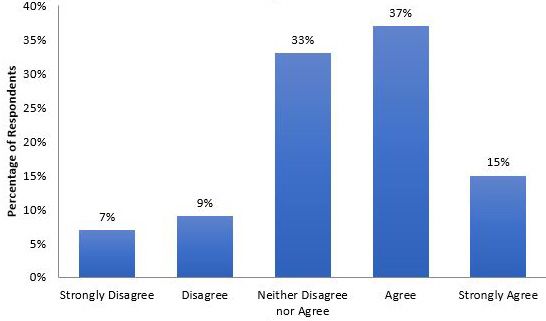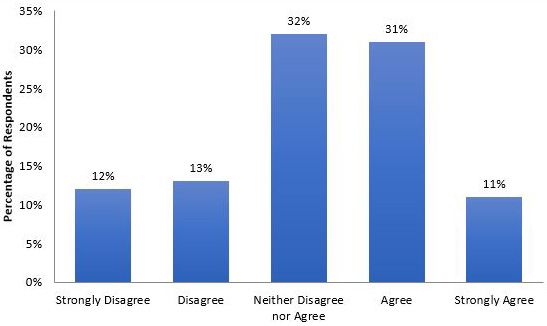This EDIS publication, focusing on Floridians' intent to purchase GMO citrus, is intended to help Extension faculty understand public perceptions regarding the use of genetic engineering to combat citrus greening. Extension faculty can use this understanding of public perceptions as they develop and deliver programming for clientele.
Introduction
Worldwide and in Florida, food-related issues such as food safety, food security, and use of new food technologies continue to be top concerns. Among the food-related issues are concerns about consuming the products from transgenic plants, often referred to as "GMOs" (Hallman et al., 2003).
The amount of genetically modified [GM] foods grown worldwide has increased dramatically in the past 20 years, rising from 4.3 million acres in 1996 to 457.4 million acres in 2016 (International Service for the Acquisition of Agri-Biotech Applications, 2017). GM food, while well understood by science, is not widely understood by public audiences, and often leaves people skeptical and unsure whether they should be eating GMOs (Funk & Rainie, 2015; MacFie, 2007; Ruth & Rumble, 2017). GM technologies provide potential solutions to many critical issues facing our food supply, including citrus greening.
Citrus greening is a disease threatening citrus production in Florida and beyond (UF/IFAS Citrus Research and Education Center [UF/IFAS CREC], 2023). The disease was found in south Florida in August 2005. Since then, it has been found in commercial and residential sites in all Florida counties that have commercial citrus (UF/IFAS CREC, 2023). While there are many management techniques, there is no cure for the disease once a tree is infected (UF/IFAS CREC, 2023). Trees infected with greening decline and produce bitter, misshapen, unmarketable fruit (UF/IFAS CREC, 2023).
Many growers have succumbed to the disease and sold their land or sought alternative crops. The United States Department of Agriculture, National Agricultural Statistics Service [USDA NASS] reported nearly 400,000 acres of abandoned citrus land in Florida between 2014-2016 (USDA NASS, 2016). Florida produced 2.2 million boxes of citrus in the 2014-2015 season and just 1.4 million boxes in the 2015-2016 season (USDA NASS, 2017). The entire industry hinges on the ability to produce a threshold level to maintain packing houses, juice plants, and support facilities. Once production drops below that level, losses will only accelerate.
Given that genetic engineering is a possible solution to this devastating disease, understanding public perceptions of GM citrus could help Extension faculty develop programming to meet the needs of Floridians. The role that Extension faculty play in helping the public understand new technologies such as genetic engineering and GM crops is important and contributes to the success of both this initiative and viable agricultural production that continues to be sustainable and profitable.
This EDIS publication will help Extension faculty understand Florida residents' perceptions of and beliefs about GM citrus and their intent to purchase GM citrus and citrus products. This understanding can equip Extension faculty to more effectively communicate with and educate clientele about this topic so that they can make informed decisions.
Background
Since Floridians' opinions of food issues are important to the sustainability of the agricultural industry, the UF/IFAS Center for Public Issues Education in Agriculture and Natural Resources (PIE Center) initiated a study to explore the attitudes, perceptions, and opinions of Floridians around food issues. In October 2013, an online survey was distributed to a representative sample of 827 Florida residents aged 18 and older using non-probability sampling; 510 completed responses were collected, for a participation rate of 61.7 percent (Rumble & Leal 2013). To ensure that respondents were representative of the 2010 U.S. Census, the data were weighted to balance their geographic location in the state, age, gender, and race (Kalton & Flores-Cervantes, 2003). The survey included questions about GMOs replicated and adapted from Bredahl (2001).
Results
Scenario: Genetic Modification as a Solution to Citrus Greening
To examine beliefs on whether genetic modification should be used as a potential solution to citrus greening, respondents were asked to read the following statement about citrus greening and its impact on the industry:
A disease known as citrus greening is spreading quickly throughout the state of Florida. The disease affects the trees' uptake of nutrients, leaving the fruit sour and the tree malnourished. There is no cure for the disease, and pesticides have failed to stop the spread of the disease that eventually kills the tree. Research has been done to find a citrus tree resistant to the disease, but none has been found. Without a solution, this disease could lead to the demise of the Florida citrus industry. Genetic modification is a possible solution for saving the Florida citrus industry.
Respondents were given the statement "Genetic modification should be used to save citrus trees" and asked to indicate their level of agreement on a five-point scale (1 = Strongly disagree, 2 = Disagree, 3 = Neither disagree nor agree, 4 = Agree, 5 = Strongly agree). After reading this description, over half (52 percent) of respondents agreed or strongly agreed that genetic modification should be used to save citrus trees, while another 33 percent of the respondents felt neutral about the use of genetic modification to save citrus (Figure 1).

Willingness to Purchase GMO Citrus and Citrus Products
To examine their willingness to purchase GMO citrus and citrus products, respondents were given the statement "I would purchase Florida-grown, genetically modified, citrus fruit and juice" and asked to indicate their level of agreement on the same five-point scale. Forty-two percent of respondents agreed or strongly agreed they would purchase Florida-grown genetically modified citrus fruit and juice, while 32 percent felt neutral about their intent to purchase these products (Figure 2).

Recommendations
After being given a specific situation about citrus greening and an explanation of its impact on the industry, respondents had fairly positive feelings about genetic modification.
Floridians were able to relate to and had an emotional reaction toward the possibility of saving citrus trees with genetic modification. From these results, personal relevance seemed to play a role in Floridians' decision-making process regarding genetic modification.
This research suggests that messages highlighting the facts and adding personal relevance about a specific situation can lead to a more accepting public. While Floridians' perceptions of GM use were more favorable in this case, almost one-third (32 percent and 33 percent, respectively) were still neutral about whether genetic modification should be used and if they would buy GM citrus and juice. This suggests that if transgenic citrus does emerge as one of the solutions to citrus greening, the citrus industry will have to develop effective strategies to communicate and market citrus products.
IFAS researchers working on solutions to citrus greening should work closely with IFAS communications and social science researchers to ensure that the research is communicated in a manner that is transparent and relevant to Floridians. Additionally, researchers throughout IFAS should collaborate to ensure that the public is informed about new solutions to citrus greening. Without public awareness and acceptance, a new solution is not guaranteed to be successful in restoring the sustainability of the industry.
Extension faculty have a role to play in working with IFAS researchers as new technologies surrounding citrus greening are developed. In addition to communicating the technology to citrus producers and the broader industry, Extension faculty should also communicate about the technology to consumer clientele so that consumers are able to make informed decisions about the technology. Extension faculty should seek guidance from IFAS Communications when discussing these concepts with clientele to ensure a consistent message is communicated to residents throughout the state.
References
Bredahl, L. (2001). Determinants of consumer attitudes and purchase intentions with regard to genetically modified foods—results of a cross-national survey. Journal of Consumer Policy 24(1), 23–61. https://link.springer.com/article/10.1023/A:1010950406128
Funk, C., & Raine, L. (2015). Public and scientists' views on science and society. Retrieved from Pew Research Center. https://www.pewinternet.org/2015/01/29/public-and-scientists-views-on-science-and-society/
Hallman, W. K., Hebden, W. C., Aquino, H. L., Cuite, C. L., & Lang, J. T. (2003). Public perceptions of genetically modified foods: A national study of American knowledge and opinion. (Publication number RR-1003-004). New Jersey: Food Policy Institute, Cook College, Rutgers, The State University of New Jersey.
International Service for the Acquisition of Agri-Biotech Applications. (2017). Pocket K No. 16: Biotech Crop Highlights in 2016. Retrieved from https://www.isaaa.org/resources/publications/pocketk/16/
Kalton, G., & Flores-Cervantes, I. (2003). Weighting methods. Journal of Official Statistics 19(2):81–97.
MacFie, H. J. (2007). Consumer-led food product development. Cambridge, UK: Woodhead.
Rumble, J. N., & Leal, A. (2013). Public opinion of food in Florida. PIE2012/13-15. Gainesville, FL: University of Florida/IFAS Center for Public Issues Education.
Ruth, T. K., & Rumble, J. N. (2017). What's in a Name? The influence of persuasive communication on Florida consumers' attitude toward genetically modified food. Journal of Applied Communications, 101(2), 72–85. https://doi.org/10.4148/1051-0834.1006
UF/IFAS Citrus Research and Education Center. (2023). Citrus greening. Retrieved from https://crec.ifas.ufl.edu/research/citrus-production/disease-identification/citrus-greening-huanglongbing/
USDA NASS. (2016, September). Citrus abandoned acres. Retrieved from https://www.nass.usda.gov/Statistics_by_State/Florida/Publications/Citrus/Abandoned_Acreage/CitAA16.pdf
USDA NASS. (2017, July). Citrus July Forecast. Retrieved from https://www.nass.usda.gov/Statistics_by_State/Florida/Publications/Citrus/Citrus_Forecast/2016-17/cit0717.pdf